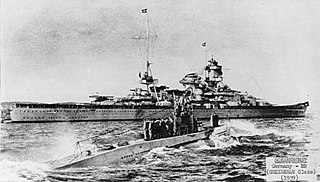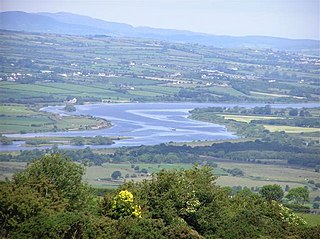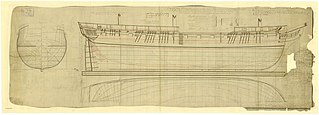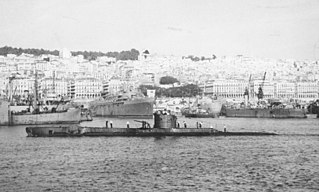
German submarine U-47 was a Type VIIB U-boat of Nazi Germany's Kriegsmarine during World War II. She was laid down on 25 February 1937 at Friedrich Krupp Germaniawerft in Kiel as yard number 582 and went into service on 17 December 1938 under the command of Günther Prien.

The River Foyle is a river in west Ulster in the northwest of the island of Ireland, which flows from the confluence of the rivers Finn and Mourne at the towns of Lifford in County Donegal, Republic of Ireland, and Strabane in County Tyrone, Northern Ireland. From here it flows to the city of Derry, where it discharges into Lough Foyle and, ultimately, the Atlantic Ocean. The total length of the River Foyle is 32 km (20 mi). The river separates part of County Donegal from parts of both County Londonderry and County Tyrone. The district of County Donegal that borders the western bank of the River Foyle is traditionally known as the Laggan. This district includes the villages of St Johnston and Carrigans, both of which are nestled on the banks of the River.
MV Princess Victoria was one of the earliest roll-on/roll-off ferries. Completed in 1947, she operated from Stranraer, Scotland, to Larne, Northern Ireland, initially by the London, Midland and Scottish Railway (LMS) until 1 January 1948 and thereafter by LMS's successor British Railways. During a severe European windstorm on 31 January 1953, she sank in the North Channel with the loss of 135 lives. This was then the deadliest maritime disaster in United Kingdom waters since World War II. For many years it was believed that 133 people had lost their lives in the disaster. However, research by a local historian, Liam Kelly, identified two other victims—Gordon Wright and Thomas Saunders—who had not been identified as there had been no passenger list at the time.

Greencastle is a commercial fishing port located in the north-east of the Inishowen Peninsula on the north coast of County Donegal in Ulster, Ireland. The port is on the western shores of Lough Foyle. Nowadays, given the decline in the fishing industry, it resembles more closely a 'typical' Donegal holiday village. It is located a few miles from Moville and is about 20 miles from Derry.

The Republic of Ireland–United Kingdom border, sometimes referred to as the Irish border or British–Irish border, runs for 499 km (310 mi) from Lough Foyle in the north-west of Ireland to Carlingford Lough in the north-east, separating the Republic of Ireland from Northern Ireland.

The Newry Canal is an abandoned canal in Northern Ireland. Opened in 1742, it was built to link the Tyrone coalfields to the Irish Sea. The navigable route ran from Lough Neagh via the Upper Bann river to Portadown, then approximately 20 miles from Portadown via the canal proper to Newry, terminating in the Albert Basin.

HMS Safari was a third batch S-class submarine built for the Royal Navy during World War II. Commissioned in 1942, she was assigned to operate in the Mediterranean Sea. During the course of the war, Safari sank twenty-five ships, most of which were Italian.

German submarine U-48 was a Type VIIB U-boat of Nazi Germany's Kriegsmarine during World War II, and the most successful that was commissioned. During her two years of active service, U-48 sank 52 ships for a total of 306,874 GRT and 1,060 tons; she also damaged three more for a total of 20,480 GRT over twelve war patrols conducted during the opening stages of the Battle of the Atlantic.

German submarine U-201 was a Type VIIC U-boat of the Kriegsmarine in World War II.

HMS Saldanha was a 36-gun fifth-rate Apollo-class frigate of the Royal Navy. She was commissioned in April 1810 and spent her entire career serving on the Irish Station, including capturing a fast-sailing French privateer on 11 October 1811. In the evening of 4 December that year Saldanha was serving off Lough Swilly when she was caught in a storm. Last seen sailing off Fanad Head, the ship was wrecked in a nearby bay with every person on board being killed and the only survivors being a parrot and a dog. The wreck was memorialised by Thomas Sheridan in his poem The Loss of the Saldanha.

SS Laurentic was a British transatlantic ocean liner that was built in Belfast, Ireland, and launched in 1908. She is an early example of a ship whose propulsion combined reciprocating steam engines with a low-pressure steam turbine.

HMS Seadog was a third-batch S-class submarine built for the Royal Navy during World War II. Completed in September 1942, she spent most of her career in Arctic waters, off Norway, but sank only one German ship in 13 patrols. In January 1945, she was redeployed to the Far East, meeting more success. On her first patrol in the area, the submarine rescued four American airmen. After two patrols, she and her sister ship HMS Shalimar sank five sailing vessels, two coasters, a barge, a tugboat and a Japanese tank landing ship. After the war ended, Seadog was sent back to England, placed in reserve, then sold for scrap in December 1947. She was ultimately broken up in August 1948.

HMS Universal (P57) was a Royal Navy U-class submarine built by Vickers-Armstrong at Newcastle upon Tyne. So far she has been the only ship of the Royal Navy to bear the name Universal.
Three vessels of the Royal Navy have been called HMS Sabre after the weapon:

SM UB-50 was a German Type UB III submarine or U-boat in the German Imperial Navy during World War I. The U-boat was ordered on 20 May 1916. She was commissioned into the Pola Flotilla of the German Imperial Navy on 12 July 1917 as SM UB-50.

A ship's boat is a utility boat carried by a larger vessel. Ship's boats have always provided transport between the shore and other ships. Other work done by such boats has varied over time, as technology has changed. In the age of sail, especially for warships, an important role was the collection of drinking water. The use of radio, followed by telex, e-mail, etc. has reduced and then replaced the need for written communications to be delivered. A large enough boat may be needed to carry an anchor to some distance away from the ship, so as to kedge out of a harbour or away from a hazard – and also to recover such an anchor afterwards. Warships have always used their boats as an extension to their military role. This includes the provision of a means of escape for the crews of fireships, the landing of troops, or the "cutting out" raids that were used by the Royal Navy, especially during the Napoleonic Wars. All these requirements competed with the need to be able to stow the boats on board in a way that did not interfere with the normal operation of the ship.

The bombing of RFA Fort Victoria took place on 6 September 1990, when a unit of the Provisional Irish Republican Army (IRA) planted two bombs aboard the Royal Fleet Auxiliary replenishment ship at Harland & Wolff shipyard in Belfast, Northern Ireland, where the vessel had been launched four months before. One of them exploded in the engine room, causing flooding and serious damage. The second device didn't explode and was defused several days later. The attack resulted in a two-year delay before Fort Victoria became fully operational.

Vice-Admiral Sir Hugh Stirling Mackenzie, was a Royal Navy officer who became Flag Officer Submarines and Chief Polaris Executive.

HMS Poppy was a Flower-class corvette that served in the Royal Navy as a convoy escort during World War II.

HMS Stephen Furness was a Royal Navy armed boarding steamer of the First World War. She was built as a passenger vessel for the Tyne Tees Steam Shipping Company (TTSSC) by Irvine's Shipbuilding & Drydock Company of West Hartlepool. She was named after TTSSC chairman Sir Stephen Furness, 1st Baronet and launched in 1910. She served on the Newcastle–London route until the First World War when she was acquired by the navy. She served on the route to Murmansk, Russia, but was sunk by a U-boat in 1917 while traversing the North Channel 10 miles east of the entrance to Strangford Lough, Northern Ireland. More than 100 men died in her sinking.





















